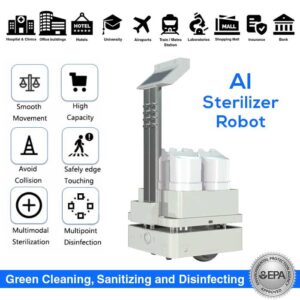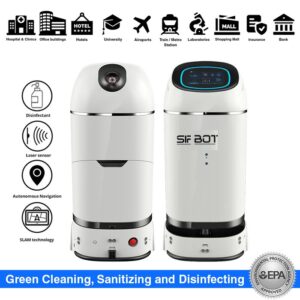Hospital Acquired Infections (HAIs) Vs. UV Disinfection Robots
Hospital Acquired Infections (HAIs) are a major problem for hospitals. On any given day, about one in every 31 hospital patients in the United States has at least one healthcare-associated infection, according to the Centers for Disease Control and Prevention. About 99,000 people die each year.
Healthcare-associated or hospital-acquired infections are infections that people get while they are receiving care for another condition. The source of these infections can be other patients, staff, visitors, or equipment, according to the agency. They can happen in any health care facility.
Not only HAIs are deadly and dangerous, they’re costly, mainly due to patients’ need for extended hospital stays and for readmission. They are also preventable.
A new range of disinfection mobile robots may help to lower those numbers. For example SIFROBOT-6.5 can autonomously move around hospitals, maneuvering hallways and tight spaces, to a designed area where it disinfects the surroundings by emitting concentrated ultraviolet light. UV eliminates bacteria and other harmful microorganisms known to cause hospital aquired infections..
UV light, one of the three types of ultraviolet rays from the sun, has a wavelength of between 200 to 400 nanometers. It’s effective at killing bacteria and viruses because it destroys the molecular bonds that hold their DNA together.
The self-moving robot platform carries vision, communications and sensor technology, and a 254 nanometer UV light system. It moves autonomously, stopping at user-predefined hotspots that require a longer time of exposure, disinfecting and killing bacteria and viruses on all exposed surfaces
An exposure time of ten minutes can kill up to 99.99 percent of pathogens. SIFROBOT-6.5 disinfects all contact surfaces as well as the air in hospital wards, corridors, and the like. The technology implies that the robot is to be used as part of the regular cleaning cycle.
In hospitals across the United States, UV light devices are primarily used to decontaminate surgery rooms and for equipment sterilization purposes. However, limited by a lack of mobility, flexibility, and the capability to autonomously position themselves in relation to the surroundings
Latest safety technologies, human error safeguards, and autonomous mobility allows SIFROBOT-6.5 to safely disinfect any surface in any enclosed hospital area, as a routine matter. The machine drives itself to a user-defined area, where it autonomously navigates while zapping bacteria and harmful microorganisms with concentrated UV light from many different angles.
Reference: UV light could reduce hospital-acquired infections
[launchpad_feedback]



